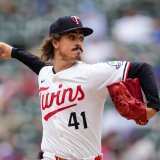Baseball Hall of Fame 2025: The remarkably similar cases for first-timers Dustin Pedroia and Ian Kinsler
Both second basemen seem to fall just short of the Cooperstown standard

In looking at the first-time players on the 2025 Baseball Hall of Fame ballot, Ichiro Suzuki initially jumps out, followed by CC Sabathia. After those two, there's a batch of intriguing players, including second basemen and former teammates Ian Kinsler and Dustin Pedroia.
Through there are differences, some that paint Kinsler as the better player and some in Pedroia's favor, their cases end up in just about the same place -- which I believe to be on the periphery here, though it's possible either or both hang around on the ballot for a while. Let's check them out, individually, before going with the head-to-head comparison for fun.
The case for Pedroia
Pedroia is one of 31 players in MLB history to win both a Rookie of the Year and MVP award. Only two did in the same year (Fred Lynn and Ichiro Suzuki for the trivia hounds out there), but Pedroia came close, winning MVP the season after Rookie of the Year.
In parts of 14 seasons, Pedroia hit .299/.365/.439 (113 OPS+) with 1,805 hits, 394 doubles, 140 home runs, 725 RBI, 922 runs and 138 stolen bases. Those counting stats aren't going to cut it, so Pedroia's case needs to come from his peak performance and how much of a winner he was.
Sure enough, if you grabbed Pedroia's prime (2008-13, which is six seasons), he hit .303/.371/.459 (119 OPS+) with an average of 5.8 WAR per season. In 2010, injuries held him to only 75 games, so we could look at the 162-game average through the prime and see 198 hits, 47 doubles, 17 homers, 83 RBI, 107 runs, 21 steals and 6.7 WAR per season. He also walked more than he struck out and played excellent defense at an up-the-middle position.
Basically, he was nearly MVP caliber when on the field for six years and has four Gold Gloves and a Silver Slugger to prove it, in addition to the MVP and Rookie of the Year.
Also, if you look at Pedroia's Red Sox from 2007 (when he won Rookie of the Year) through 2013 (the last year of his prime), they won the World Series twice and went 7-2 in the nine playoff series in which he appeared. There was some clutch in there, too. In the 2007 ALCS, the Red Sox famously came back from a 3-1 deficit. In the three wins to steal the series, Pedroia, a rookie, went 7 for 13 with three doubles, a home run, five RBI and six runs. He was big in Game 2 of the 2013 ALCS and Game 2 of the 2013 World Series as well, just to name two more examples.
The JAWS system shows Pedroia is a bit below the average current Hall of Famer at second base. He sits 19th all-time, ahead of Hall of Famers like Bobby Doerr, Nellie Fox, Tony Lazzeri and Johnny Evers while trailing non-HOF types (though that could change in the next few years for some) like Chase Utley, Lou Whitaker and Willie Randolph.
The case for Kinsler
Since we're already in the JAWS mindset, I'll point out that Kinsler ranks 21st to Pedroia's 19th (funnily enough, Jose Altuve sits between them, which means by this time next year it's very likely Pedroia and Kinsler will sit back-to-back). In WAR, Kinsler leads Pedroia and we'll get to that.
Kinsler has four All-Star Games and two Gold Gloves with his one World Series ring (2018 Red Sox). He doesn't have an MVP, though he got votes four times (topping out at 11th in 2011).
In parts of 14 seasons, Kinsler hit .269/.337/.440 (107 OPS+) with 1,999 hits, 416 doubles, 41 triples, 257 home runs, 909 RBI, 1,243 runs and 243 stolen bases.
He topped 40 doubles three times and joined the 30-30 club (homers and steals) twice.
Many will point to Pedroia's postseason successes over Kinsler's, but Kinsler's teams actually went 7-3 in playoff series and he played in three World Series. He also hit .274/.369/.417 with 10 doubles, four homers, 23 RBI and 22 runs in 48 career playoff games.
Who wins?
Not everything is a head-to-head battle, but it's entirely possible these two players could be facing off for the last vote on the ballots of some individual voters. It's also a bit fun to face them off, given that they were teammates, briefly, at Arizona State before Kinsler transferred to Missouri and then later teammates with the Red Sox as Kinsler was acquired via trade to replace the injured Pedroia.
Kinsler wins the WAR battle, 54.1 to 51.9, but Pedroia's higher peak puts him ahead in JAWS, 46.5 to 46.1.
Kinsler has more hits, runs, doubles, triples, home runs, RBI and stolen bases. He also had over 1,500 more plate appearances.
Pedroia has a higher batting average by 30 points and an OBP lead of 28. Kinsler wins by one point(!) in slugging percentage, giving Pedroia the win in OPS (it's 28 points again due to rounding). Pedroia's 113 OPS+ beats Kinsler's 107.
Looking at defensive WAR, Pedroia wins 15.5 to 15.1.
On a rate basis, Pedroia was better and he displayed the higher upside between the two. But longevity often matters in Hall of Fame cases. Kinsler racked up 320 more runs, 117 more home runs, 184 more RBI and 105 more steals. Are those enough to make up for some small discrepancies in some of the rate stats (and a decent gap in batting average)?
Pedroia's shortfall is due to injuries and sometimes there's consideration given to that. Others that's just part of what separates Hall of Famers from those who fell short. You only need to look as far as Don Mattingly on the ballot.
Do they get in?
Utley is pretty clearly superior to both players. He got 28.8% of the vote last year, so it'll be tougher sledding for Pedroia and Kinsler.
My best guess is neither ever make it in the Hall of Fame via the BBWAA ballot, though maybe Pedroia gets in via a committee vote a long time down the line. I think Pedroia is held in higher esteem in baseball circles and therefore has a better chance and will get a higher vote percentage here in the first BBWAA ballot. I'm pretty confident Pedroia will remain on the ballot past the first year and it's possible Kinsler does as well. I also think there's a decent chance Kinsler falls off this year.
Regardless, if we're talking about their chances in the 2025 Hall of Fame vote, neither are getting in.
If pinned down for a ballpark guess, I'll say Pedroia gets around 15% of the vote while Kinsler is right around that 5% mark.


















